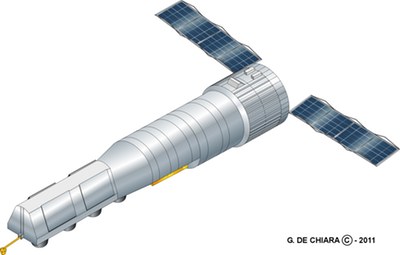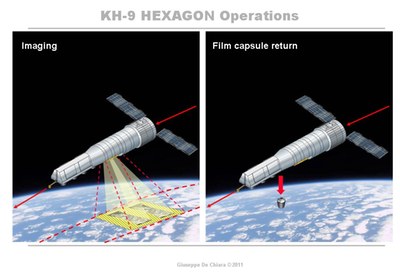The flight of the Big Bird (part 3)The origins, development, and operations of the KH-9 HEXAGON reconnaissance satelliteBurning HEXAGONSometime, probably in 1970, a high-resolution KH-8 GAMBIT reconnaissance satellite reentered the atmosphere and part of its payload was discovered in a farmer’s field in England. (See “Ike’s gambit: the KH-8 reconnaissance satellite”, The Space Review, January 12, 2009.) This apparently sent shock waves through the US intelligence community and all the way up to the White House. Soon White House aides ordered the National Reconnaissance Office to determine just how much of its satellites would survive reentry. (See “Black fire: de-orbiting spysats during the Cold War”, The Space Review, October 25, 2010.) The NRO—working with the Air Force—conducted a series of six reentry tests. The first group, involving four KH-8 GAMBIT satellites, presumably at the end of their missions, was conducted from February 1971 to April 1972 and known as the Vehicle Atmospheric Survivability Tests.
In May 1973 the NRO resumed the testing, this time renamed Vehicle Atmospheric Survivability Program, or VASP. Instead of the long, slender KH-8, they used the bus-sized KH-9 HEXAGON. The HEXAGON had a diameter twice that of the KH-8, and it was also longer. Its camera system and forward section were also considerably bulkier and heavier than the KH-8. Mission 1205 had been launched in March 1973 and was the first mapping mission. The May 1973 test used an ARIS tracking ship, two ARIA aircraft with their big bulbous noses, and a land-based radar at Shemya, Alaska. Ground controllers sent a command to the KH-9 to turn around and fire its rocket engine to slow the spacecraft so that it reentered the atmosphere. Around 45 nautical miles (83 kilometers) up, as atmospheric drag increased, the solar arrays peeled back, snapped at their struts, but remained attached to the spacecraft. Shortly afterwards, several objects broke off of the spacecraft. At about 42 nautical miles (78 kilometers) altitude the vehicle came apart, smearing flaming debris through the sky. Some of this debris was tracked, giving an indication of where it would impact the ocean. Like the earlier VAST tests, this controlled reentry indicated that a spacecraft did not heat up very much while still high in the atmosphere. Heating only really occurred at lower altitudes, meaning that it occurred as the vehicle was much closer to the Earth—and, most importantly, that the vehicle would not completely vaporize before large pieces reached the ground. What the test also indicated was that it was possible to target the debris for a specific spot, and that’s what the NRO controllers decided to do for their next test. In October 1973 the NRO sent another KH-9, this time Mission 1206, to a fiery end, this time using an ARIS tracking ship, a TRAP tracking aircraft, and three ARIA aircraft. They wanted precise data this time. Whereas the May VASP reentry was into the open ocean, this one was into Eniwetok Lagoon, and was also monitored by underwater listening devices and a submarine. According to a report, the data gathered by the TRAP aircraft on the second reentry “was remarkable and extremely informative.” Apparently the aircraft’s optical sensors were able to see quite a bit of the vehicle while it was inside the atmosphere, possibly even identifying specific parts. Part of the KH-9’s massive camera system consisted of two big cylinders nearly a meter in diameter and two meters long. Those were among the most important pieces for the observers—if a big piece of a KH-9 camera survived all the way to an impact in Siberia, the Russians could learn a lot about the top secret intelligence technology. We do not know if the Air Force recovered any of the HEXAGON’s debris from the bottom of the lagoon. Although there is not clear information on this subject, it seems likely that after this second test the NRO adopted a policy of sending all of its reconnaissance satellites to a controlled reentry into a remote part of the ocean, dropping them in deep water where the Soviets would have no chance of recovering them.
Improving the breedThe first six KH-9 HEXAGON missions had lifetimes of 40 to 91 days. Mission 1207, launched in November 1973, increased this to 123 days, and the next several missions had lifetimes from 109 to 158 days. Mission 1213, launched in June 1977, had a lifetime of 179 days. Certainly this increase in lifetime resulted from technical improvements to the spacecraft. But there may have been other external factors that changed the way the NRO operated the KH-9, driving them toward keeping the Big Bird in orbit for longer periods of time.
By the mid-1970s the NRO was operating not only the KH-9, but the older KH-8 GAMBIT high-resolution satellite. The KH-8 had debuted in 1966 and had been upgraded several times since. It was a truly powerful camera that operated in a low orbit, giving it the ability to spot incredibly small objects on the ground. Like its bigger brother, the KH-8 also used film that it returned to Earth in reentry vehicles. But soon the 8 and 9 were joined by an entirely new type of satellite. Starting in December 1976 with the launch of a Titan III from Vandenberg Air Force Base, the KH-11 KENNAN electro-optical imaging satellite entered service. An advanced version of this satellite was reported to be in service as of 1990 and descendents are still in operation today. The KH-11 did not return its images on film in reentry vehicles. Instead, it beamed them up to communications relay satellites that sent the data down to a ground station inside the United States. As a result, the images were seen by human eyes within minutes of being taken, rather than the days required to return film images to Earth. But there were drawbacks. The KH-11 could not image the vast areas photographed by the KH-9, nor could it produce the incredible detail in KH-8 GAMBIT photographs. The KH-11 was launched atop the same Titan III rocket as the KH-9 and was roughly the same size. It supplemented the earlier satellite, but did not fully replace it for many years. Because it did not require film, the KH-11 could stay in orbit for an extended period of time—from three to five years vs. the maximum of 275 days for the KH-9. It operated in a higher orbit that did not suffer the effects of atmospheric drag as much as the KH-9. Although it was substantially different in operation, the KH-11 may have benefitted from the KH-9’s technology, particularly its Satellite Control Section. The SCS had a series of twelve compartments mounted around a ring. Two of these rings were stacked atop each other, with a large spherical propellant tank inside them and a rocket engine at the back. The KH-11 had the same diameter because it shared the same Titan III rocket, and probably used a variation of the SCS. In addition to technical improvements and the debut of the KH-11, there may have been another reason for the HEXAGON’s increasing lifetime: changes in the arms race between the superpowers. By the latter 1970s the Soviet ICBM arsenal had reached maturity and their construction had leveled off. They were building fewer new missile silos for the HEXAGON to keep track of. The US intelligence community may have concluded that fewer updates from the KH-9 were required compared to early in the decade. One major question that remains unknown is if the NRO ever considered adapting the KH-9 HEXAGON for launch aboard the Space Shuttle at Vandenberg Air Force Base. By the late 1970s, the US government planned on transitioning all national security payloads to launch on the space shuttle. It is possible that some spacecraft scheduled for retirement in several years, like the HEXAGON, might have been exempted. But we do know that shuttle was originally supposed to be in service by the late 1970s and the KH-9 was not retired until 1986. The HEXAGON (10 by 53 feet, 3 by 16 meters) would have easily fit within the shuttle bay (15 by 60 feet, 4.6 by 18.3 meters). But it might have required extensive modifications to ride in the shuttle. Satellites are designed to withstand certain loads in certain directions. Think of a layer cake—it sits perfectly fine on its plate, but falls apart when turned on its side. What complicated satellites intended for the shuttle was that they had to be designed not only to face in the vertical direction while the shuttle was sitting on its pad, but also had to be able to face in the horizontal direction if the orbiter had to return to Earth with the payload still inside. Although we do not know if the HEXAGON was ever considered for shuttle launch, we do know that the NRO suffered some bitter internal disputes over moving its reconnaissance payloads to the shuttle. (See “The spooks and the turkey”, The Space Review, November 20, 2006) But as the HEXAGON entered its second decade of operation, the program managers began to prepare for its end. They didn’t realize how tragically it would go, with a boom, not a whimper. Next: The Final Flight of the Big Bird Home |
|

